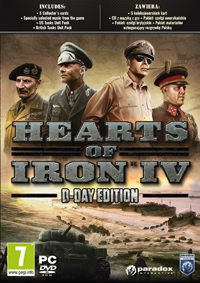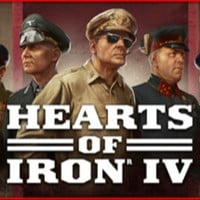Hearts of Iron IV Review – The Art of War
After seven long years, Hearts of Iron makes a big comeback. Ladies and gentlemen, the season for sleepless nights full of orders, international schemes, and endless taste of defeat is now officially open!
The review is based on the PC version.
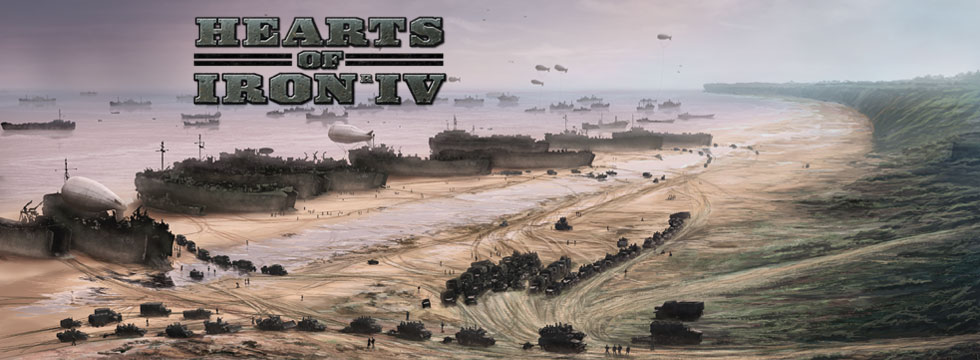
- Detailed and polished war mechanics;
- Impressive complexity and scope of gameplay;
- Ruthless AI;
- Very good diplomacy and politics system;
- Each playthrough is a unique experience;
- Fitting, aesthetic graphics.
- Pretty unrealistic commerce mechanics;
- Too simple economy;
- No spies;
- Not very accurate tutorial;
- Some flaws in the system of national focus.
The Swedish Paradox studio have been known for their particular knack for developing strategy games for years. They are the people who gave us Cities: Skylines, and the recently released Stellaris. However, their CV is much richer than that: three other series have a special place there since the beginning of the 21st century: The cult Europa Universalis, its younger brother, Crusader Kings, and Hearts of Iron itself. In time, those games became classified as a separate sub-genre – grand strategy games. They’re based on a rather uncommon concept of managing whole nations in real-time with use of active pause, on a huge world map, in a scale unparalleled by any other game.
Among the big three, Hearts of Iron, taking the players to the times of WW2, was always regarded as the most complex and focused mostly on combat aspect of the gameplay. Still, it has gathered a most dedicated fanbase of gamers, who eagerly uncovered the deepest secrets of the game, then shared their advice and strategies with others. So Paradox faced a double challenge: not only did they have to make a game that would be good in the general sense, but they were also aware that every change they decide to make will be closely examined by the veterans of the franchise. Despite that, the fourth part is not short on new features, which are clearly there to open the game to wider audience. Have the Swedes managed to maintain the demanding nature of this game?
Global scope
In Hearts of Iron IV, we have the ability to play virtually any country that was on the maps in the 1930s. The game does suggest that certain countries will be more interesting to play than others, but nothing is stopping us from selecting El Salvador or Luxemburg. The countries that were the leading forces of World War Two are obviously richer in details: they have their own inventions, appropriate national goals and historical leaders – the elements which are generic for other nations. The game can either be started in 1936, if the players want to have the ability to prepare the economy and army for war, or in 1939, if they just want to join the global conflict as soon as possible. There’s one more interesting choice before starting the game: apart from three levels of difficulty, the players can decide whether they want the AI to act in accordance with history, or become more flexible and search for ways which are not always in line with history books. While the great scope is the defining feature of Hearts of Iron, it’s also a great advantage for it in general sense.
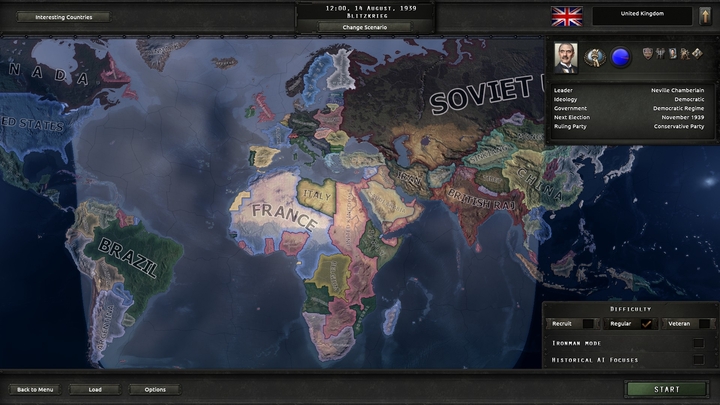
Fumes from factories
In terms of the emphasis the game places on certain elements, they can basically be divided into two groups: war and everything else (i.e. economy, commerce, research, international affairs, and so on). However, this doesn’t mean that smaller elements are of lesser importance; in this game, the country must run like a well-oiled machine – neglecting one of these elements will quickly result in a chain-reaction, and deteriorate the performance of the army.
The economy in Hearts of Iron is the element which was often simplified in the previous games, and the outcome wasn’t always good. The base of all our actions are civilian factories, which directly influence the economic potential of the country. Building new factories is the main task during peace time – but it requires... already existing civilian factories. Furthermore, the factories are also needed for erecting the rest of the infrastructure: bunkers, radars, refineries, airports, or shipyards. Exiting this vicious circle is really hard for countries that don’t have many factories in the beginning of the game, regardless of the territories they control or their population. This element was present in previous parts, and instead of getting rid of such unrealistic dependence of economy on just one type of building, the devs actually decided to emphasize this even more. Another simplification that has no apparent justification is the fact that in IV, there is no need to provide consumable goods for the population. Instead, a percentage of factories determined by the chosen economic policy is automatically assigned to the task. This means that the problem of unhappy population is no longer here – it used to depend on the amount of consumable goods provided for the population, which was more realistic and added certain depth to the gameplay.
The other side of the economy is obviously the arms industry – the production of equipment for the army is based on military factories and shipyards. The situation here is much better than in the civic economy. All the necessary hardware – rifles, artillery, cars, tanks, airplanes, or ships, have to be assigned to a production line, and then the player assigns a number of factories that will work on the given product. This allows the player to gather resources for the upcoming war or to decree a modernization of the military equipment. At the beginning, the production lines have minimal efficiency, which will increase over time, but will lessen whenever we want to modify the line. This clever solution forces the player to think ahead and manages to render the actual latencies of the economy.
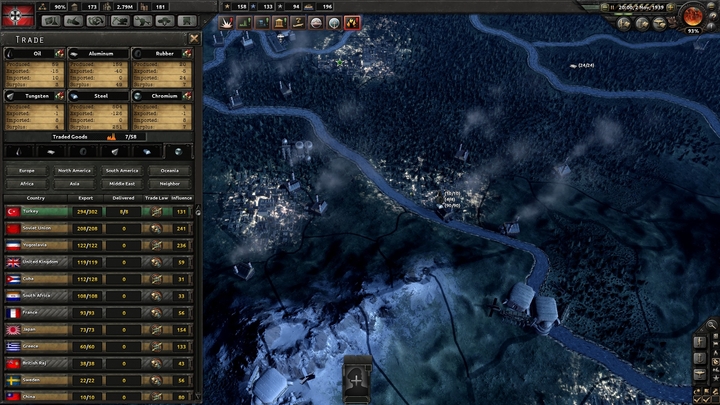
The production of arms requires six different raw materials. They can be extracted and mined from certain provinces; oil and rubber can be manufactured in the specific building. Most of the times the requirements of the production are too high, however, and this is the point where arguably the worst part of the game pops up – commerce. For reasons that are hard to explain, the developers abandoned the idea of money in this game. In previous parts, money could be obtained by selling surplus resources or by means of domestic trade. This time, instead of money, the currency is... (you guessed it) civilian factories. To say nothing of the ludicrous idea of trading buildings overseas, this solution has one main disadvantage: it doesn’t allow stockpiling resources. Then there’s the system of export, which doesn’t allow the player to control what do they actually sell – it’s determined by only one, universal edict, so it means that you’re selling all resources at the same time, and if you’re short some, you have to buy them back.
Political mastery
Hearts of Iron IV has, however, an incredibly rich layer of political actions, both on the ground of domestic policy and international relations. The game never seems to be confused with our conduct, even if it’s different than the actual historical events. The AI always reacts accordingly, the press headlines, flags of countries and leaders’ profiles always seem to make sense. This provides the unique opportunity to change the history without losing the connection with it.
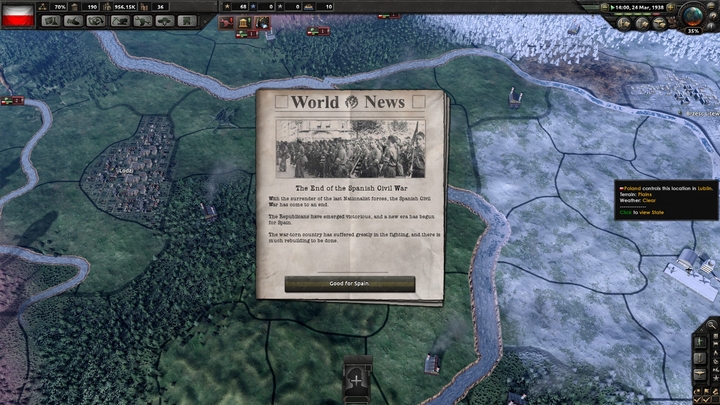
The main tool for realizing the vision of our country are the national focus trees, which give access to economic, scientific, military, and political bonuses. Completing each goal takes 70 days and requires 1 point of political power per day. The player decides which goals they want to achieve, but sometimes, apart from having all the required goals complete, some prerequisites also have to be met. The developers have admitted in one of their diaries that the general concept of this element was often changed and caused much discussion. This hesitation is unfortunately visible – many of the goals seem futile; in fact, they can hardly be called a national focus. The only reason for completing them is to gain access to more serious ones. Also, I found it rather unrealistic that every goal, no matter how profound or banal it is, takes exactly 70 days to be completed. The players don’t have any control over the research, other than just choosing the goal. But despite those shortcomings, this element can still be called an advantage; the ability to directly influence the development of a country in all aspects, the power of the national focus trees, together with the possibility to create own faction, change ideology or annex lands, provides a lot of diversity in the gameplay.
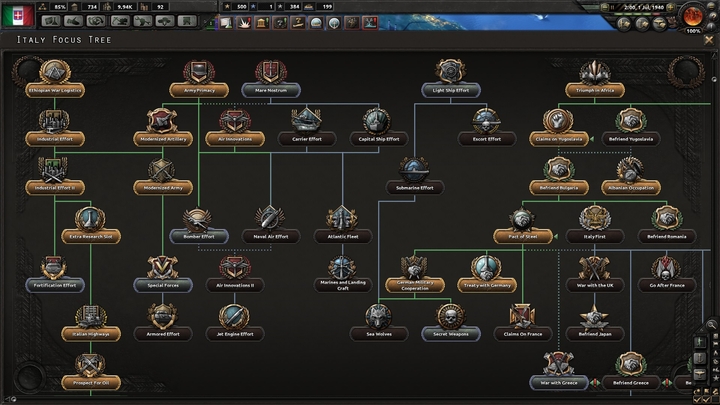
At the front
In accordance with the tradition of the series, war is the key and the most detailed ingredient of Hearts of Iron IV. Players have control over ground troops, navy, and air force, and they also manage modernizing, supplying and training their armies. All these elements are very detailed and make the game complete.
The system for commanding land units is a slightly improved version of the ideas that you might remember from one of the DLCs for the Hearts of Iron III, called The Finest Hour. The divisions are combined into armies, the players designate the lines of the front, offensive and retreat. These allow to prepare a very detailed plan of attack, which will then be executed automatically by our generals. That’s truly a great solution – it also manages to render the tactics of WW2. In contrast to the previous game, there are only three levels of command: divisions, command groups, and theatres, which combine the groups. I think one more level wouldn’t hurt; having access to corps level would make the management of multi-stage plans much easier, and would also help to avoid splitting infantry and armor because of generals’ special attributes. Operations of navy and air force are based on missions. Assigning wings – squadrons of airplanes – to given areas allows them to support land units, bomb cities or just protect your airspace. Achieving domination at sea is also pretty important, since it allows you to control supply routes and prevent transport of hostile troops.
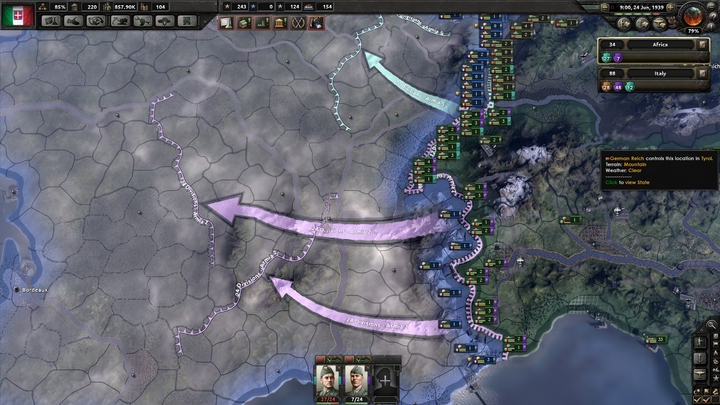
The great advantage of the game is the powerful division designer, which allows for a precise choice of battalions and support, so that the recruited units fit the kind of force that the enemy has, as well as the terrain and weather conditions, which are also an important factor of battles. Here, the military aspect of Hearts of Iron IV reaches a whole new quality, a finesse which can only be recognized by those players who manage to get through the initial struggles, and achieve proficiency in commanding the armies.
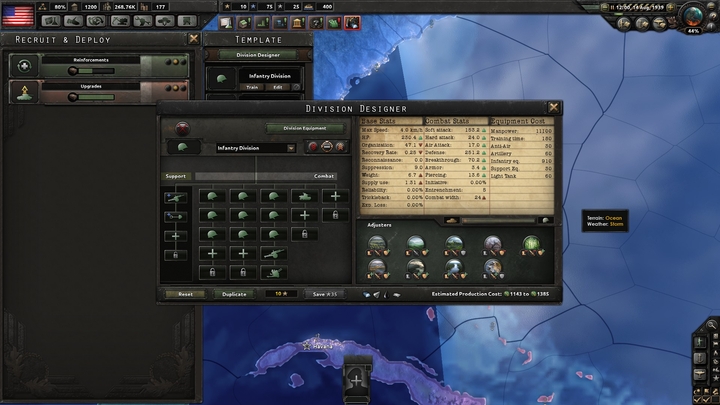
The AI also deserves a word of praise – it’s aggressive and it can exploit any weak spots in our defense, especially if we chose to free it from the bonds of history before beginning the game. The enemy tries to encircle our units so they have no way of retreating, rationally manages its own troops and doesn’t try to stick its fingers where it’s hot. Our own generals sometimes need some assistance since they are rather strict in the execution of our orders, which often means that they will miss good tactical opportunities, but nothing is stopping us from issuing orders ourselves if need be.
The system of alliances and factions also works very well – attacking one country means its allies will strike back. A good example of how easy it is to be unexpectedly stabbed in Hearts of Iron IV is the time when I played Italy. I was doing pretty good on the French and Yugoslavian fronts, but I left the center of my country without sufficient defense; British paratroopers landed in Genoa, and took control over Rome with a swift attack. It was impossible to bring the reinforcements in time, and when they have finally arrived, the soldiers were too tired to successfully fight for the capital.
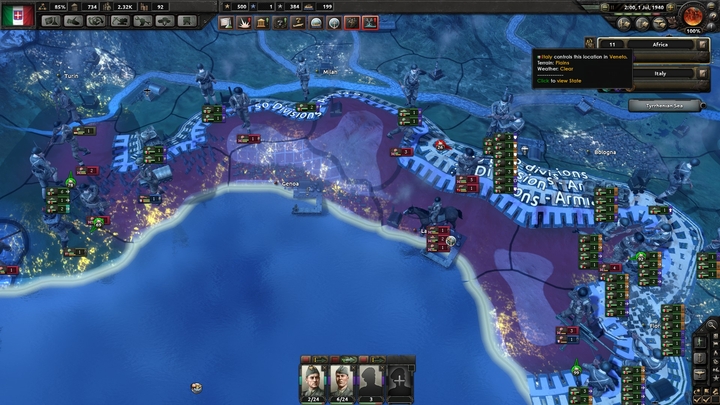
Quite a view
Visually, the game has changed beyond recognition. The interface is now much more transparent and legible. The big charts that looked more like Excel forms were turned into elegant windows. All the portraits, pictures and icons also look great and are very consistent. The same goes to the loading screens, which build a nice atmosphere before the game even begins. But the best new feature in terms of graphics is the new, 3D map, which – thanks to the new engine called Clausewitz – brought Hearts of Iron one step closer to Total War games. The regions are represented by appropriate color palettes, and after the dawn, the cities turn into realistically looking clusters of shimmering light. The music provides a good final touch, but the soundtrack becomes pretty repetitive after a while.
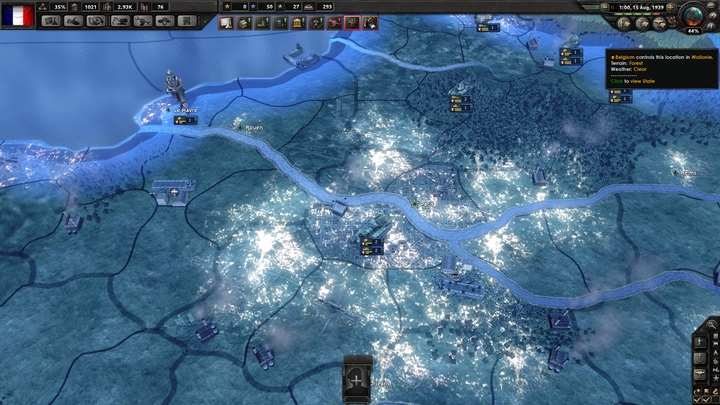
Bull’s eye
All in all, Hearts of Iron IV is a very good game. Despite the solutions in the economic layer which sometimes are rather inapt, the deep and captivating mechanics, as well as the great combat system, make this game a real treat for the hardened tacticians. And all that is covered with very nice graphics, which fit the mood well.
Although the game is much more approachable for the new players than any of the previous parts, it remains a complicated and demanding title. Doubtless, its greatest advantage is the replayability – each playthrough will be totally different, demanding new tactics and ideas. Thanks to the promised mod support and add-ons which will probably soon start appearing as DLCs, we can hope for even more.
Hearts of Iron IV
Hearts of Iron IV Review – The Art of War
After seven long years, Hearts of Iron makes a big comeback. Ladies and gentlemen, the season for sleepless nights full of orders, international schemes, and endless taste of defeat is now officially open!
